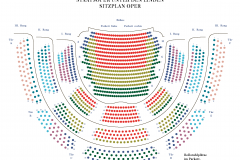The Turn of the Screw
April 2026 | ||||||
|---|---|---|---|---|---|---|
Mo | Tu | We | Th | Fr | Sa | Su |
The Turn of the Screw
Opera in a prologue and two acts (1954)
Music by Benjamin Britten
text by Myfanwy Piper after Henry James
Duration: Approximately 1 hour 45 minutes, without intermission
Language: Performed in English, with German and English surtitles
Recommended age: 14 years and older
A young woman is given a job as a governess at a country house, Bly, where she will be looking after two orphan children, Flora and Miles. She has been hired by the children’s uncle and guardian, who doesn’t want to be bothered by anything and who makes the young woman swear to absolute secrecy about the goings-on at his estate. Mysterious things do indeed start to happen at the house, including strange behaviour by the children. She also finds something inscrutable about the housekeeper Mrs Grose, who has apparently spent half her life at Bly. Later, the governess believes she sees hazy apparitions of a man and a woman gliding through the rooms of the house, and she identifies them as the spirits of former employees Peter Quint and Miss Jessel. Demonic forces appear to be running rampant and plaguing the characters. At the end, one thing is certain: one of the characters lies dead. Everything else remains unanswered …
Benjamin Britten’s mysterious, arresting chamber opera The Turn of the Screw has a fragmented structure that reflects the main character’s own apparently fragmentary and possibly distorted perceptions and memories. Each scene casts a different light on the events, which are viewed through the lens of the governess’s memories. They do not coalesce into a unified whole, but instead feel more like a puzzle with missing pieces. Britten’s opera is based on an 1898 novel by Henry James that was influenced by early ideas of depth psychology. James once described the novel, with some understatement, as a "play of strange encounters".
Plot
Prologue
A woman from a modest background, the daughter of a countryside vicar whose name we will never learn, is named governess at the country estate of Bly. Here, she is to take care of the two orphans Flora and Miles and provide for their upbringing. Her employer is the children’s uncle, who refuses to be bothered with such matters. A great responsibility weighs upon her shoulders.
Act one
With great dedication, the governess approaches her task at Bly. Alongside the two children, there is also the housekeeper Mrs. Grose. At first, the closed off cosmos of Bly with the angelic children seems like a perfect idyll. And yet, gradually, the untarnished nature of this world is shaken to the core. A letter arrives; Miles has been expelled from school. The reasons are unclear, leading to an initial sense of unease. The governess believes she sees spectral beings wandering across the rooms of Bly. Mrs. Grose thinks she can recognize the former employees Quint and Jessel, who died under mysterious circumstances. The governess is convinced that Miles and Flora are in danger and that she must protect her charges and save them. In her fantasy, she hears voices calling for the children.
Act two
The governess now can hardly find her way around Bly. She feels lost in her own "labyrinth" and the screw of disorientation continues to turn until she goes completely mad. The voices she hears become louder, the danger seems to grow. The governess tries to order events, as if she were reassembling the parts of a puzzle over and over again. Everywhere she suspects deception and seduction, is just about to flee. But then she decides to tell the uncle of the events. Due to this climax in events, Mrs. Grose leaves the house with Flora and travels to London. The governess is left behind with Miles, and is finally able to understand.
Program and cast
Musical Director: Finnegan Downie Dear
Director: Claus Guth
Set Design, Costumes: Christian Schmidt
Light: Sebastian Alphons
Prologue, Peter Quint: Stephan Rügamer
Governess: Christiane Karg
Miles: Nicolò Balducci
Flora: Regina Koncz
Mrs. Grose: Rosie Aldridge
Miss Jessel: Anna Samuil
Staatskapelle Berlin
State Opera Unter den Linden
Staatsoper Unter den Linden is one of Berlin's most prestigious opera houses, with a rich history and significant cultural impact.
History:
The Staatsoper Unter den Linden was originally built between 1741 and 1743, under the direction of architect Georg Wenzeslaus von Knobelsdorff. It was commissioned by Frederick II of Prussia and was initially named the Königliche Oper (Royal Opera). The opera house has undergone several renovations and reconstructions, notably after World War II damage. It reopened in 1984, following a major renovation.
Construction:
The original design was characterized by its Baroque style, featuring an elegant façade and a grand entrance. The building was reconstructed in the 1950s and 1980s, maintaining its classical exterior while modernizing the interior. The façade features a classic portico with six Corinthian columns and a prominent central pediment.
Interior:
The interior is known for its opulent and classical design. The auditorium is renowned for its acoustics and grandeur, with luxurious velvet seats and elaborate decorations. The stage and seating areas have been updated to meet modern performance standards while preserving historical aesthetics.
Concerts and Performances:
The Staatsoper Unter den Linden hosts a variety of performances, including operas, orchestral concerts, and ballet. It is home to the Staatskapelle Berlin, one of Germany's leading orchestras. The opera house is celebrated for its high-quality productions and its role in Berlin’s vibrant cultural scene.
JOURNEY
The Staatsoper Unter den Linden has completely barrier-free access due to its excellent public transport connections.
ADDRESS: Unter den Linden 7; 10117 Berlin
SUBURBAN RAILWAY
S+U Friedrichstraße (S1, S2, S5, S7, S25, S75)
SUBWAY
Hausvogteiplatz (U2)
Museumsinsel (U5)
Stadtmitte (U2, U6)
Unter den Linden (U5, U6)
BUS
Staatsoper (100, 245, 300)
Unter den Linden/Friedrichstraße (100, 147, 245, 300, N6)
PARKING
Q-PARK parking garage Unter den Linden/Staatsoper
Bebelplatz, 10117 Berlin
There are five electric charging stations in the parking garage. Further information can be found here.
The underground car park on Bebelplatz offers disabled parking spaces and direct access to the opera house. On entering the car park between 5.30pm and 11.30pm, the maximum parking fee is €7. To use this tariff, enter your parking ticket in one of the pay machines and the message »Theatertarif« will appear on the display. Please note that it is not possible to use the tariff if you enter the car park before 5.30pm. so it will not be shown on the display. TIP: If you pay the theatre tariff at the pay machine before the event, you can avoid unnecessary waiting after the show.

 EN
EN DE
DE IT
IT FR
FR ES
ES RU
RU JP
JP RO
RO
 Seating plan
Seating plan 